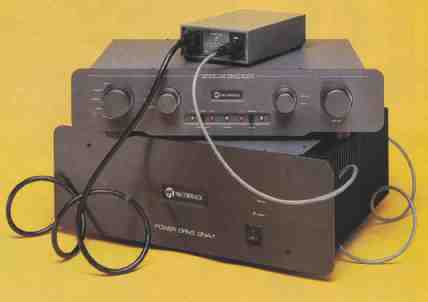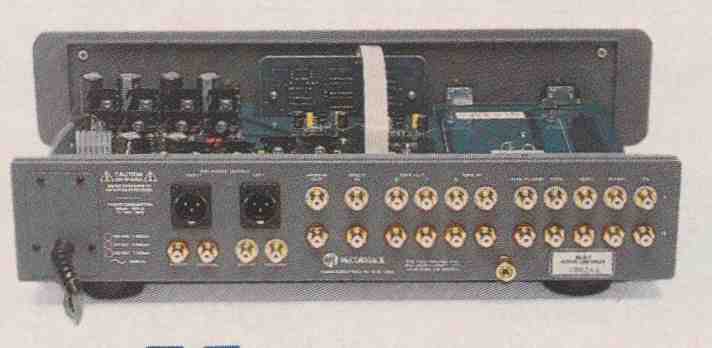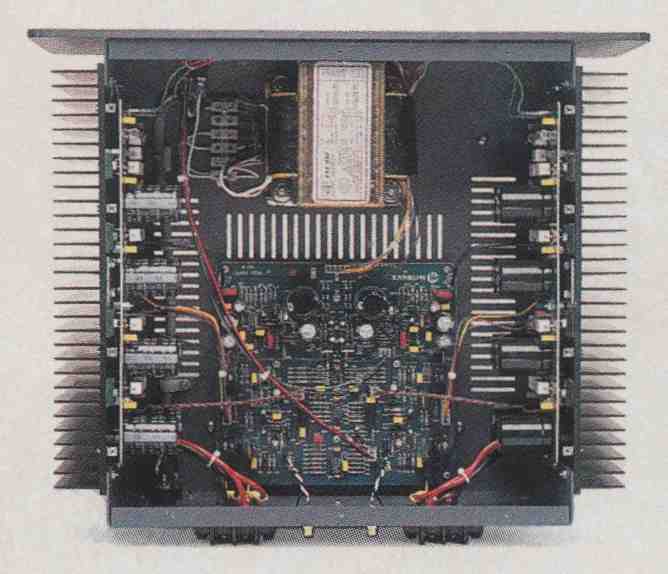McCormack Audio may seem like a new high-end firm to many readers. However, Steven McCormack is a leading high-end designer who began his work by modifying products of other firms back in the early 1970s, and he headed a company called The Mod Squad, from which McCormack Audio has evolved. Steven is also the originator of Tiptoes, was one of the first high-end designers to produce a CD player whose sound lived up to its technical promise, and has designed several excellent passive preamps as well as the components reviewed here.
Opening the McCormack DNA-i power amplifier and ALD-1 preamplifier immediately reveals that they are not the sort of luxury high-end products where the case costs more than the average mid-fl system. They do have excellent circuit board construction and layout, and both products reveal the designer’s focus on use of a minimum number of quality active and passive components in the signal path.
At $1,745 [ca. 1993], the ALD-1 Active Line Drive preamp combines excellent European-oriented styling with a set of features that offer maximum flexibility with the least possible interference with the input signal. The source selector handles five high- level inputs, though an optional plug-in phono preamplifier card is available for one of these inputs. This card can be used with both moving-coil and moving-magnet cartridges, and it has a switch to choose between 40- or 55-dB gain. The phono preamp is said to meet the RIAA frequency response curve within ± 0.25 dB and to have a S/N ratio of better than 75 dB with moving-coil cartridges and above 80 dB with moving-magnet cartridges.
The input selector feeds a tape monitor switch that allows you to choose between source and two additional buffered tape feeds. A separate switch, with LED indicators, controls the two tape monitor loops to allow bidirectional dubbing; it disconnects the tape buffer op-amps from the main audio circuitry (to eliminate any coloration from the tape decks and associated circuitry) when they are not being used. The McCormack ALD- 1 also has a muting switch, with LED indicators, that can mute the output of either or both channels.
The tape monitor control feeds a wideband buffer stage with two complementary J-FET transistors in each channel that act as an impedance transformer with a gain of one. The output of this stage feeds a switch that allows you to choose between the normal inputs with gain and a sixth direct input that bypasses the buffer. The output of this switch, in turn, feeds the volume control.
The volume control can either feed directly into the power amplifier through the passive output jacks or into the input of the line amplifier. This amplifier is a wideband discrete J-FET and MOS-FET circuit with no nested or loop feedback, and it is d.c. coupled from input to output with servo control to keep d.c. offset under 3 mV. A fully symmetrical balanced output is provided, with XLR jacks, as well as two sets of single-output RCA jacks with inverting and noninverting polarities.
This set of features gives you exceptional flexibility in using the ALD-1 as anything from a passive to an active preamp. The de sign ensures that the ALD-1’s unusual range of input features can be used with the minimum amount of passive and active circuitry, regardless of which mix of features you select. This purism does, how ever, have one drawback. The ALD-1 does not have a balance control, a feature that has been dropped from some other purist designs. While many audiophiles never the soundstage to provide the precise balance that locks in the left-to-right imaging, thereby centering the soundstage.
Two other features of the ALD-1 are of special interest. The power supply provides ± 22 V d.c. regulators for each channel, using a discrete circuit that has very fast response times. McCormack feels this method is sonically superior to conventional IC regulators.
The McCormack Power Drive DNA-1 amplifier has the same styling as the ALD-1 and costs $1,995. Its only front-panel features are a power switch and power and protection-circuit LEDs. The back has RCA inputs, but not balanced inputs. The speaker connections include a choice of binding posts or rugged terminal blocks that provide an exceptionally firm connection with spade lugs. The unit measures 19 x 7 x 15 inches and weighs about 50 pounds.
Internal construction quality is excellent. McCormack uses a copper-plated steel chassis and double-sided, plated-through, glass-epoxy boards with thick copper traces. The DNA-1 has quality parts, such as Wima film capacitors, Holco and 1% Resista metal-film resistors, Toshiba and Hitachi transistors, and Wonder solder. The large toroidal power transformer is custom built for this application.
The DNA-1 has an input impedance of 100 k-ohms, an input sensitivity of 1.0 V rms, an output impedance of less than 0.1 ohm, and a servo-controlled d.c. offset of less than 5 mV. It is noninverting, has a wide bandwidth of—3 dB at 0.5 Hz to 250 kHz, a rise-time of less than 2 p and a slew rate of 50 V per uS. It delivers (per channel) 150 watts into 8 ohms, 300 watts into 4 ohms, or 500 watts into 2 ohms, and can be easily modified to drive even 1-ohm loads.
A high-current design, the DNA-1 is capable of 50 amperes peak current per channel and has a moderately high damping factor of greater than 100 into 8 ohms at 1,000 Hz. This is enough power and cur rent to drive virtually all modern speakers, although it’s not the kind of brute-force design that offers extremely high damping factors, power, and control into the most demanding loads.
The circuit is a direct-coupled, low-feed back design using J-FETs, MOS-FETs, and bipolar devices in a fully complementary configuration. At the input, two J-FETs are connected as a complementary differential amplifier, with source degeneration. The two sections of this stage produce signals of opposite polarity, which are direct coupled to the gates of a complementary MOS-FET pair, operating Class A, push-pull, and with a gain of approximately 10. This stage provides low-impedance drive for the bi polar output section.
The output stage consists of four complementary pairs of bipolar transistors (eight devices per channel). These are used in parallel, as emitter followers, to provide an output current capability exceeding 50 amperes. A low-value (0.47-ohm) emitter resistor is used with each output device to equalize current under very high drive conditions.
A d.c. servo amplifier reduces output offset to below 5 mV and allows the use of a direct-coupled circuit with a very-low-frequency cutoff. The output of this servo connects through an isolation resistor to the bottom of the feedback resistor at the input of the amplifier. The servo response is set below 1 Hz, providing stability with out limiting the DNA-1amplifier’s low- frequency performance.
Unlike the ALD-1, the DNA-1 does use limited amounts of feedback. An RC network provides approximately 6 dB of voltage feedback to the input source’s resistor junction. This provides gain consistency and further reduces any small distortion products that may be generated in the earlier stages. No inductive or RC networks are required at the output because the amplifier circuit already is stable at all applicable frequencies.
The output stage’s power-supply rails are fed by a high-current winding on the power transformer. There are separate ultra-high-speed, 25-ampere bridge-rectifier blocks for each amplifier channel. The power filtration is handled by eight distributed 4,700-p.F capacitors per channel, located close to the eight output transistors, and each bypassed by high-quality film- type capacitors. This provides low impedance and fast current-delivery response to each output device. These capacitors are considered individual current-reservoir nodes, giving the unit its Distributed Node Amplifier designation.
Like many modern high-quality line stage preamps, the McCormack ALD-1 has comparatively little sound character of its own. Further, you can bypass much of the little sonic character the preamp does have make any use of the balance control, I find it to be extremely important in adjusting by using the direct input and passive out put. In practice, I preferred using the ALD 1’s direct input from my primary D/A converter, and the normal active outputs for all inputs. I find that under most real- world listening conditions, it is better to have some gain in the preamp circuit, even if this means a marginal amount of extra noise and a slight veiling of detail. The gain provided musical life and dynamics, and I did not detect any significant coloration, change in the soundstage, or difference in musical dynamics. In fact, when I inserted the ALD-1 into the tape monitor loop of my reference preamp and adjusted for gain, the sound was remarkably neutral and transparent. All I could detect was a very slight loss of low-level information and an increase in noise that slightly elevated the upper midrange when I got within a few feet of my speakers—a listening position that no one would adopt in practice. There is no such thing as a straight wire with gain, but the ALD-1 comes close. Most important, it does not impose any new character on the music.
The McCormack DNA-1 amplifier has more active circuitry and a more distinctive sound character. However, the DNA-1’s sound character complements that of the ALD-1 and is in many ways a mirror image of it.
The DNA-1 has a flat, open sound with a great deal of information in the upper midrange and the treble. It is not treble heavy or bright, nor does it have a “tube” sound that rolls off the upper octaves or has a forgiving character. What goes in is what you hear coming out. At the same time, the bass and midrange are powerful and provide a proper balance in overall timbre.
The deep bass of the DNA-1 is a bit too warm on occasion, and I would prefer more tightness, detail, and control. How ever, the DNA-1 reproduces the excitement that can only come from good bass power, and which is vital to symphonic music, opera, and jazz.
The DNA-1’s performance in the mid- bass to lower midrange is very good to excellent, and it’s better controlled than the deep bass. This amp does an excellent job of reproducing dynamics, and transient definition is excellent. The mid-bass to lower midrange has the natural warmth of music and does not add dryness or leanness to the music. Many transistor power amplifiers still have a problem in this region. The DNA-1 has a natural midrange balance, sounding more like some of the best modern tube amplifiers than many transistor amplifiers. At the same time, the DNA-1 has a very “live” midrange, in contrast to the more “liquid” midrange of tube and hybrid units. This sound is exciting and involving with good recordings, although it also makes you feel as if you were sitting slightly more forward in the hall.
The upper midrange and treble are consistent with the DNA-1 midrange sound. There is a great deal of excitement, information, and energy—which are not exaggerated—but this does place a premium on good recordings and system balance. The DNA-1 worked well with speakers as diverse as Apogee Divas and Thiel CS-5s, though it is not the amplifier for speakers with a rising treble or which lack the bass power and extension to counterbalance highly revealing upper octaves. In terms of music, the DNA-i does a very good job in reproducing the upper midrange and treble of reference quality CDs, but it also is all too accurate in reproducing the kind of irritating “in your face” close miking that some producers insist upon. Exactly why any producer should record a harpsichord as if the listener was chained to the instrument is beyond me, but the DNA-1 will add a touch of added energy to such recordings rather than being forgiving.



The DNA-1 does an excellent job of handling dynamic peaks as well as low-level dynamics and transient detail. It is a touch more live and dynamic than most power amplifiers, but it is also free of the slight constriction of musical energy that occurs during loud passages with many amplifiers in its price range.
The DNA-1 has very good transparency. In fact, music detail and definition are excellent for a unit in its price range, al though it’s not equal to the very best amplifiers. The ALD-1 and DNA-1 do an excellent job of working together to enhance transparency.
The DNA-1 has a wide and open sound-stage, with good depth. The imaging is excellent and has a great deal of openness and air. The DNA-1 does a better job reproducing the left-to-right arc of instruments with complex music than it does with layers of front-to-back depth. It does particularly well in reproducing the imaging and soundstage of natural chamber music and jazz recordings. I also found that it involved me in the performance rather than called my attention to its sonic details. If you are a bit tired of units that etch the imaging or divide the orchestra artificially, you will like the DNA-1.
The ALD-1 and DNA-1 performed well with every component I used. The one reservation I have is that the DNA-1 has better bass definition and control with speakers that do not require extreme re serves of power or very high damping factors, though this is true of every amplifier I have reviewed in this price range.
The McCormack Audio ALD-1 and DNA-1 both qualify as excellent products in their price range, offering a clearly de fined set of musical choices and sonic nuances. They are not the units for those who like their music to be polite, who want equipment that softens the upper octaves or who accept speakers without bass power and extension. This pair is, however, an excellent alternative for anyone who wants a modern high-end system that covers the entire frequency range, who is willing to become deeply involved in the music, and who stresses accuracy over a forgiving nature.
This article adapted from Audio magazine, August 1993.
============